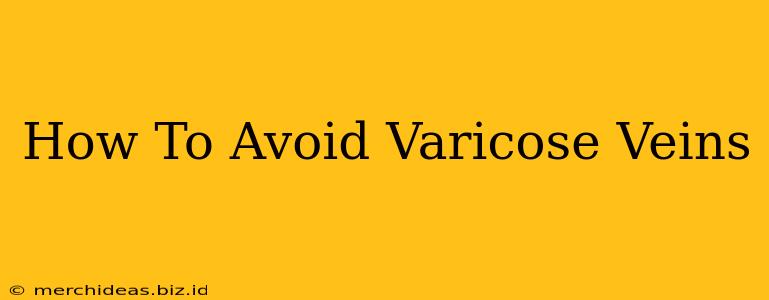Varicose veins, those unsightly and sometimes painful bulging veins, are a common concern for many. While genetics play a role, lifestyle choices significantly impact your risk. This comprehensive guide will equip you with the knowledge and strategies to significantly reduce your chances of developing varicose veins.
Understanding Varicose Veins
Before we delve into prevention, let's understand what causes varicose veins. Essentially, they occur when the valves in your veins weaken, allowing blood to pool and increase pressure within the veins. This pooling leads to the characteristic bulging and discoloration. Several factors contribute to this valve weakening:
Risk Factors for Varicose Veins:
- Genetics: A family history of varicose veins increases your risk substantially.
- Age: The risk increases with age, as vein valves naturally weaken over time.
- Gender: Women are more prone to varicose veins due to hormonal influences.
- Pregnancy: The increased blood volume and pressure during pregnancy put extra strain on the veins.
- Obesity: Excess weight adds pressure to the veins in your legs.
- Prolonged Standing or Sitting: Lack of movement restricts blood flow, increasing venous pressure.
- Smoking: Smoking damages blood vessels, increasing the risk of varicose veins.
Proactive Steps to Prevent Varicose Veins
Now that we understand the risk factors, let's explore actionable strategies to minimize your risk:
1. Maintain a Healthy Weight:
Losing even a modest amount of weight can significantly reduce the pressure on your veins. Focus on a balanced diet and regular exercise.
2. Get Regular Exercise:
Regular physical activity, particularly low-impact exercises like walking, swimming, and cycling, improves circulation and strengthens leg muscles, supporting venous return. Aim for at least 30 minutes of moderate-intensity exercise most days of the week.
3. Elevate Your Legs:
Elevating your legs above your heart several times a day, even for short periods (15-20 minutes), helps reduce venous pressure and improve circulation. This is especially beneficial after periods of prolonged sitting or standing.
4. Wear Compression Stockings:
Compression stockings gently squeeze your legs, improving blood flow and reducing swelling. They are particularly helpful for individuals who spend long hours on their feet. Consult your doctor for proper sizing and recommendations.
5. Avoid Prolonged Standing or Sitting:
Take frequent breaks to move around and stretch your legs if your job requires you to stand or sit for extended periods. Regular movement is crucial for maintaining healthy circulation.
6. Quit Smoking:
Smoking significantly damages blood vessels, increasing your risk of various circulatory problems, including varicose veins. Quitting smoking offers numerous health benefits, including reducing your risk of varicose veins.
7. Healthy Diet:
A diet rich in fruits, vegetables, and whole grains supports overall cardiovascular health, contributing to healthy veins.
When to See a Doctor
While prevention is key, it's essential to seek medical attention if you experience:
- Painful or swollen legs: Severe pain or swelling could indicate a more serious underlying condition.
- Leg ulcers: These are open sores that may develop in severe cases of varicose veins.
- Skin discoloration or changes in skin texture around your veins: These could be signs of venous insufficiency.
Your doctor can diagnose varicose veins and recommend appropriate treatment options if necessary.
Conclusion: Preventing Varicose Veins is Within Your Reach
By adopting these preventative measures and maintaining a healthy lifestyle, you can significantly reduce your risk of developing varicose veins. Remember, proactive steps are far better than reactive treatments. Prioritizing your circulatory health today will benefit you for years to come. Consult your doctor for personalized advice and to address any concerns.
